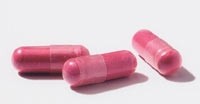Cranberry industry develops standard PAC testing method

According to Dr Ronald Prior from the US Department of Agriculture (USDA), one of the lead researchers on the project, a consistent testing method is necessary in order to allow for the accurate comparison and communication of PAC levels.
Currently, manufacturers of cranberry extracts and cranberry products do not have a consistent industry-wide method to measure and quantify these compounds in their products. As a result, communication of the health benefits of cranberry products becomes challenging, as there is no standard guarantee that the products contain sufficient quantities of PACs.
Best compromise
Dr Prior, together with Dr Amy Howell from Rutgers University, evaluated existing testing methods, including DMAC, vanillin reaction and HPLC.
None of these are perfect, explained Dr Prior, but it was necessary to find “the best compromise” so that proper comparison could be made between research results.
The method they settled on is based on the DMAC (dimethylaminocinnamaldehyde) process, but includes some modifications designed to improve it and make it easier to use.
“Our team has analyzed a number of different methods, and the DMAC method is the most robust, easiest and least expensive way to quantify cranberry PACs,” said Dr Howell.
“A standard method to quantify the PACs in cranberries is invaluable to the future of cranberry science and to the consumer. When you have a ‘superfruit’ with clear benefits, it is imperative to guarantee that the amount of the active component has been quantified and standardized in a reliable, valid way.”
The method works by using a compound that reacts with PACs and creates a color. This is then analyzed to measure the concentration of PACs, which can then be translated into a percentage.
The research is being conducted in collaboration with Brunswick Laboratories, Norton, MA and Agrobios Laboratories in France, as well as the Cranberry Institute, an industry association.
Developing health claims
In 2004 France became the first country to approve a health claim for the North American cranberry species Vaccinium macrocarpon, which states that it can 'help reduce the adhesion of certain E.coli bacteria to the urinary tract walls' if it contains 36mg of PACs.
The French health claim was based on a version of the DMAC model, but it was proprietary and therefore could not be accessed by most labs, explained Dr Prior.
There is no similar claim currently available for use in the US, and European health claims are currently undergoing a regulatory re-vamp, which adds urgency to the need to develop a standardized testing method, said Dr Prior.
He told NutraIngredients-USA.com that the DMAC version that he and his research team have developed is currently undergoing a multi-lab validation process – their standardized protocol has been sent to five separate labs in the United States, France and China in order to test whether the same values are reproduced from lab to lab.
If the results are positive, the protocol will be submitted for publication in a peer-reviewed journal, and would then be freely available for use throughout the industry. Assuming things run smoothly, this could take around five months to complete, said Dr Prior.
European action
A similar initiative is currently underway in Europe. Three European cranberry extract suppliers formed a new association earlier this year with the explicit aim of clarifying standards governing the manner in which PAC content is communicated to consumers.
Burgundy Botanical Extracts, Diana Naturals, and Tournay Biotechnologies say the European Association for the Valorization of Cranberry (Euracran) will work towards establishing a common standard for determining PAC content based on the European Pharmacopoeia.
“Many methods exist for the determination of PACs: DMAC, vanillin, Bate-Smith, HPLC, European Pharmacopoeia,” Euracran said in a statement.
“All these methods of analysis of PACs were tested, compared, assessed, especially in terms of reproducibility, reliability and ease of implementation avoiding uncertainties related to the protocol. The consolidation of all these results led Euracran to guide its choice to the method of the European Pharmacopoeia.”
Dr Prior said this is a “different approach. In our experience, that kind of process is subject to variability,” he told NutraIngredients-usa.com.





















